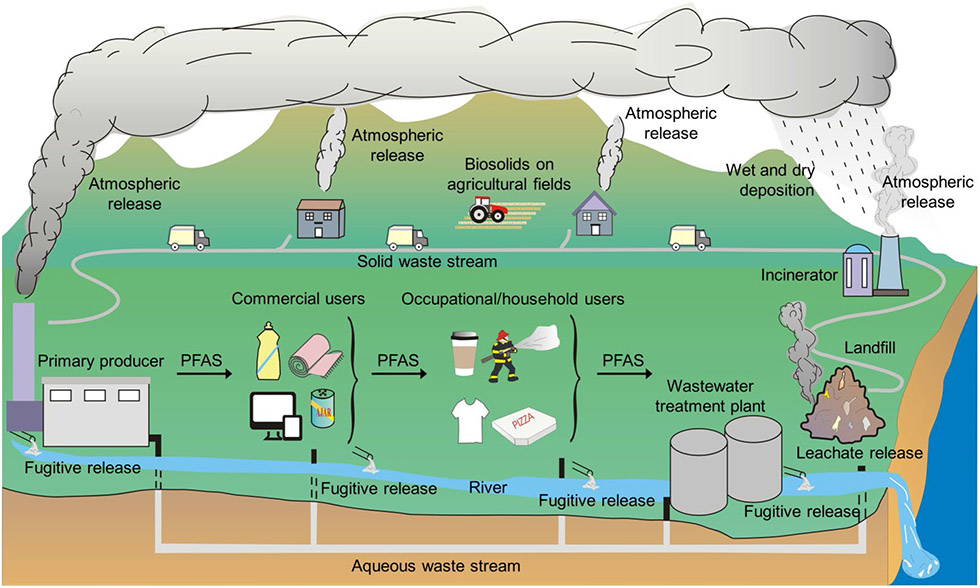PFAS and Health
What current studies have shown:

Current studies have shown that exposure to PFAS can lead to:
- Reproductive effects
- Decreased fertility
- increased high blood pressure in pregnant women
- Developmental effects or delays seen in children
- Low birth weight
- Accelerated puberty
- Bone variations
- Behavioral changes
- Increased risk of some cancers; prostate, kidney, and testicular
- Weakened immune system due to reduced ability of the body to fight infections, including reduced vaccine response
- Interference with the body’s natural hormones
- Increased cholesterol levels and/or risk of obesity
PFAS chemicals stay in our bodies and in the environment for a long time, giving them the nickname “forever chemicals.” It is still not clear all the ways they impact human health. At very high levels, there is greater concern about health effects.
Your participation in the STRIVE study will help us learn whether presence of these chemicals over a long period of time increases the risk of liver disease or liver cancer as well as other adverse health effects.
How are we exposed to PFAS?
Because of the widespread use of PFAS, these chemicals have ended up in our water, soil, and air.

Science. 2022 Feb 4; 375(6580): eabg9065.
Published online 2022 Feb 4. doi: 10.1126/science.abg9065
Most of us have been exposed to PFAS at low levels even though these chemicals do not exist naturally in the environment. This is because there are thousands of different types of PFAS which are used for many different things and in many different products.
What products contain PFAS?
Because of their strong carbon-fluorine bonds, this makes them useful for making products non-stick, water resistant, and stain resistant.
Here are some examples of products that PFAS are included in:
- Non-stick cookware
- Grease-resistant food packaging
- fast food containers/wrappers
- microwave popcorn bags
- pizza boxes
- candy wrappers.
- Water and stain repellent marketed products including:
- Carpets
- Furniture / upholstery
- Clothing
- Car seats
- Mattresses
- Fabrics
- Cleaning products
- Cosmetics / beauty products
- Shampoos
- Dental flosses
- Paints, varnishes, and sealants
- Biosolids – for example fertilizer from wastewater treatment plants that are used on agricultural lands can affect ground and surface water and animals that graze on the land.
Resources to learn more:
Federal Links:
The Environmental Protection Agency (EPA) is a federal resource with information about environmental topics impacting the United States. Here, you will find information on PFAS and more information about the EPA’s response and regulation to PFAS along with more information, tools and resources.
EPA: Our Current Understanding of the Human Health and Environmental Risks of PFAS
The Agency for Toxic Substances and Disease Registry (ATSDR), based in Atlanta, Georgia, is a federal agency. ATSDR strives to protect communities from hazardous substances by helping with environmental health emergencies, researching environmental health threats, including hazardous waste sites and helping guide action at state and local health partners.
North Carolina-Specific Links:
The North Carolina Department of Environmental Quality (DEQ) is an agency protecting North Carolina’s environmental resources. They specifically focus on air quality, water quality, energy strategies and the public’s health. DEQ works to educate businesses, farmers, local governments, and the public to encourage responsible environmental behavior.
Georgia-Specific Links:
The Environmental Protection Division (EPD) of the Georgia Department of Natural Resources is a state agency that helps protect and restore Georgia’s environment, leading the cause to have clean air, water and land. They partner with other organizations, aiming to lead to a vibrant economy and healthy communities.
EPD: PFOA and PFOS Information
Sources with general PFAS information:
Six Classes is a website created to bring awareness about the six classes of toxic chemicals that are regularly used in consumer products. This website was created by the Green Policy Institute to help educate the public on these classes and to partner with scientists, regulators, businesses and public interest groups to reduce the use of these chemicals.
Here you can find PFAS specific information.
PFAS Central works to share news, scientific papers and PFAS related events. You will also find other PFAS related tools and information on their website.
This website was created by the Green Policy Institute to help educate the public on and to partner with scientists, regulators, businesses and public interest groups to reduce the use of harmful chemicals.
Contact Us
Phone
Call us with questions or to sign up
919-515-7630
Email us questions or to sign up
STRIVE_study@ncsu.edu




